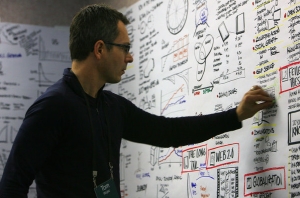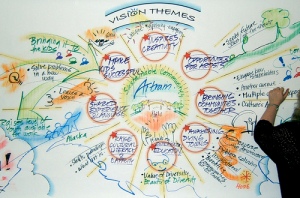Tom Wujec is a Fellow at Autodesk, the world’s leader in 2D & 3D design software. He has brought several software applications to market, including SketchBook Pro, PortfolioWall, and Maya which won an Academy Award for its contribution to the film industry. Given Tom’s expertise with technology and software, some might find it surprising to learn that he is also a pioneer in the use of simple, interactive visuals to help teams solve problems. Using images, sketches, and animations, Tom and his team make complex ideas understandable by making them visible and tangible.
So why should Tom’s work at Autodesk be of interest to you? As I have written before, neuroscientists have discovered that we don’t actually “see the world as it is.” Rather, our brain filters the information it receives based on past experiences to create the view of the world we have around us. As Tom describes it, our brains conduct a “visual interrogation” of everything we see by asking a series of questions and creating a mental model based upon the answers. The depth and variety of questions our brains ask (where, how, location, number, why, color, when, shape, size, what) is dictated by the richness of the images it encounters. The richer and more diverse the images, the more of the brain’s three primary regions are utilized in processing the image to create meaning.
Since one of our goals as leaders is to improve the effectiveness of our organizational problem solving, Tom’s work provides us with a couple of interesting lessons:
First, make problem solving more visual. Rather than merely using data points and words to describe, analyze and solve problems, use images. Images help the brain clarify ideas, identify underlying patterns of logic, and create meaning. As opposed to numbers and words, a good visual invites the eyes to dart around and engage the entire brain to create a visual logic and make sense of the information to which it is being exposed. The more fully the brain is engaged in the act of analyzing and creating meaning, the richer the outcome of the problem solving activities will be.
Second, make your problem solving more interactive. The act of creating a visual narrative of the problem solving process is critical to the team’s ownership of the problem as well as their engagement in finding a solution. The more the team creates the visual logic used to tell the story of the problem and what caused it, the more vested they will be in the outcome.
Creating a culture of continuous improvement requires both engaging people in the process of identifying and solving problems as well as providing them with the tools to do so. Most traditional approaches to problem solving fail to inspire people and generate creative solutions. They lack both a visual component to kick the entire brain into action as well as a sufficient level of interactivity to create ownership between the team and the problem. By challenging teams to use images to identify underlying patterns and create meaning, you just might be surprised at the improvement in both the quality of thought as well as improvement ideas.





Leave a Reply